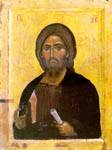|
|
| Portable Icons |
13th c., last quarter Vatopedi Monastery Wood, egg tempera, 57 x 43 cm |
|

|
The two icons of Christ (no. 2.11) and the Virgin (no. 2.10), with the same dimensions, are contemporary works by the same artist. They were probably despotic icons on the iconostasis of a small chapel at the end of the thirteenth century; though, being relatively small, they may alternatively have been devotional icons. In the icon of Christ, the subject is portrayed as the Pantokrator, the all-ruling Lord of the universe, from the chest up, in slight contrapposto, the body being turned to his right and the head and gaze to his left. His right hand emerges from his himation in a gesture of blessing, and he holds a closed scroll in his left hand. He wears an aubergine tunic with a pink and gold clavus, and a deep red himation covering both shoulders. On the gold field are the inscriptions: 'Jesus Christ' and 'The Pantokrator'. The stern figure of Christ, with the long narrow face and rugged features, is an iconic and iconographical type also seen in the icon of Christ Pantokrator at Ochrid (1262-3), which was painted when Constantine Cabasilas was archbishop (Djuric 1961, no. 2. Mueller - Djordjevic 1984, no. 6), and in a thirteenth- to fourteenth-century icon of Christ belonging to Vatopedi Monastery (Tsigaridas 1996 (1), p. 364, fig. 309). As regards style, Christ's face is rendered with limited brown shading and large areas of ochre highlighted with flowing striations, which help to bring out the volume of the face. A similar technique is seen in the mosaic Pantokrator in the Church of the Panagia Parigoritissa in Arta (ca. 1290), which, according to Orlandos, imitates techniques typically used in portable devotional icons (Orlandos 1963, p. 123, pl. 1, 11). In conclusion, this icon of Christ Pantokrator, with its frowning expression and stern oblique gaze attesting a return to Comnenian models, belongs among the iconic types and artistic trends of the second half, and more specifically the last quarter, of the thirteenth century.
| |
|
Bibliography: Tsigaridas 1996 (1), p. 365, fig. 310.
| ||
| E.N.T. | ||
| Index of exhibits of Monastery of Vatopedi 13th century |
||
Reference address : https://www.elpenor.org/athos/en/e218ab11.asp